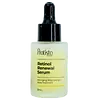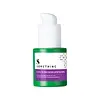What's inside
What's inside
 Key Ingredients
Key Ingredients

 Benefits
Benefits

 Concerns
Concerns

 Ingredients Side-by-side
Ingredients Side-by-side

Water
Skin ConditioningNiacinamide
SmoothingPolysorbate 20
EmulsifyingButylene Glycol
HumectantHydroxypropyl Cyclodextrin
MaskingXylitylglucoside
HumectantAnhydroxylitol
HumectantGlycerin
HumectantEthoxydiglycol
HumectantPhenoxyethanol
PreservativeRetinol
Skin ConditioningAllantoin
Skin ConditioningAcrylates/C10-30 Alkyl Acrylate Crosspolymer
Emulsion StabilisingXylitol
HumectantCaprylic/Capric Triglyceride
MaskingDimethicone
EmollientAloe Barbadensis Leaf Juice Powder
Skin ConditioningCetearyl Dimethicone Crosspolymer
Glucose
HumectantTriethanolamine
BufferingDisodium EDTA
Water, Niacinamide, Polysorbate 20, Butylene Glycol, Hydroxypropyl Cyclodextrin, Xylitylglucoside, Anhydroxylitol, Glycerin, Ethoxydiglycol, Phenoxyethanol, Retinol, Allantoin, Acrylates/C10-30 Alkyl Acrylate Crosspolymer, Xylitol, Caprylic/Capric Triglyceride, Dimethicone, Aloe Barbadensis Leaf Juice Powder, Cetearyl Dimethicone Crosspolymer, Glucose, Triethanolamine, Disodium EDTA
Water
Skin ConditioningButylene Glycol
HumectantSqualane
EmollientNeopentyl Glycol Diheptanoate
EmollientPentylene Glycol
Skin ConditioningDipentaerythrityl Hexa C5-9 Acid Esters
Skin ConditioningBetaine
HumectantPolyglycerin-3
HumectantEthylhexyl Methoxycinnamate
UV Absorber1,2-Hexanediol
Skin ConditioningCetyl Ethylhexanoate
EmollientHydrogenated Olive Oil Unsaponifiables
Emollient4-T-Butylcyclohexanol
MaskingAllantoin
Skin ConditioningPoloxamer 235
EmulsifyingAcrylates/C10-30 Alkyl Acrylate Crosspolymer
Emulsion StabilisingHydrogenated Lecithin
EmulsifyingXanthan Gum
EmulsifyingRetinol
Skin ConditioningSodium Dilauramidoglutamide Lysine
HumectantPolysorbate 20
EmulsifyingSodium Ascorbate
AntioxidantSodium Phytate
Ethylhexylglycerin
Skin ConditioningEpigallocatechin Gallate
AntioxidantBHT
AntioxidantDisodium EDTA
Phenoxyethanol
PreservativeBHA
AntioxidantTocopherol
AntioxidantWater, Butylene Glycol, Squalane, Neopentyl Glycol Diheptanoate, Pentylene Glycol, Dipentaerythrityl Hexa C5-9 Acid Esters, Betaine, Polyglycerin-3, Ethylhexyl Methoxycinnamate, 1,2-Hexanediol, Cetyl Ethylhexanoate, Hydrogenated Olive Oil Unsaponifiables, 4-T-Butylcyclohexanol, Allantoin, Poloxamer 235, Acrylates/C10-30 Alkyl Acrylate Crosspolymer, Hydrogenated Lecithin, Xanthan Gum, Retinol, Sodium Dilauramidoglutamide Lysine, Polysorbate 20, Sodium Ascorbate, Sodium Phytate, Ethylhexylglycerin, Epigallocatechin Gallate, BHT, Disodium EDTA, Phenoxyethanol, BHA, Tocopherol
Ingredients Explained
These ingredients are found in both products.
Ingredients higher up in an ingredient list are typically present in a larger amount.
Acrylates/C10-30 Alkyl Acrylate Crosspolymer is a synthetic polymer. It is used to thicken and improve the texture of products. Due to its properties, it can prevent water and oil ingredients from separating.
Allantoin is a soothing ingredient known for its protective and moisturizingg properties. Because of this, it is often added to products with strong active ingredients.
Studies show higher concentrations of this ingredient can promote wound healing.
Though it can be derived from the comfrey plant, allantoin is produced synthetically for cosmetic products to ensure purity.
Learn more about AllantoinButylene Glycol (or BG) is used within cosmetic products for a few different reasons:
Overall, Butylene Glycol is a safe and well-rounded ingredient that works well with other ingredients.
Though this ingredient works well with most skin types, some people with sensitive skin may experience a reaction such as allergic rashes, closed comedones, or itchiness.
Learn more about Butylene GlycolDisodium EDTA plays a role in making products more stable by aiding other preservatives.
It is a chelating agent, meaning it neutralizes metal ions that may be found in a product.
Disodium EDTA is a salt of edetic acid and is found to be safe in cosmetic ingredients.
Learn more about Disodium EDTAPhenoxyethanol is a preservative that has germicide, antimicrobial, and aromatic properties. Studies show that phenoxyethanol can prevent microbial growth. By itself, it has a scent that is similar to that of a rose.
It's often used in formulations along with Caprylyl Glycol to preserve the shelf life of products.
Polysorbate 20 is made by combining ethoxylation of sorbitan, ethylene oxide, and lauric acid. It is a mild cleansing agent, surfactant, and emulsifier.
As a surfactant, it helps collect dirt and oils for washing. Emulsifiers prevent oils and water from separating.
Polysorbate 20 also adds scent to a product. Since it is made using sorbitol, it has a sweet scent. Sorbitol can also be found in fruits such as apples and peaches.
The lauric acid used to create Polysorbate 20 is often derived from coconuts.
Polysorbate 20 may not be fungal acne safe.
Learn more about Polysorbate 20Retinol is a gold-standard ingredient for anti-aging. It is a form of Vitamin A and belongs to the class of retinoids that also includes tretinoin.
Why is retinol famous?
It has the most scientific studies backing up its skin benefits out of all the non-prescription ingredients.
Retinol is proven to:
This is why retinol is effective at removing wrinkles, fading dark spots, treating acne, and reducing the appearance of pores.
Studies show retinol is less effective when exposed to UV. Be sure to look for appropriate packaging to keep your retinol potent (similar to Vitamin C).
Using retinol or any retinoids will increase sun-sensitivity in the first few months. Though studies show retinoids increase your skin's natural SPF with continuous use, it is best to always wear sunscreen and sun-protection.
We recommend speaking with a medical professional about using this ingredient during pregnancy.
Retinol may cause irritation in some people, so be sure to patch test. Experts recommend 'ramping up' retinol use: start using this ingredient once a week and work up to using it daily.
Read about Tretinoin
Learn more about RetinolWater. It's the most common cosmetic ingredient of all. You'll usually see it at the top of ingredient lists, meaning that it makes up the largest part of the product.
So why is it so popular? Water most often acts as a solvent - this means that it helps dissolve other ingredients into the formulation.
You'll also recognize water as that liquid we all need to stay alive. If you see this, drink a glass of water. Stay hydrated!
Learn more about Water